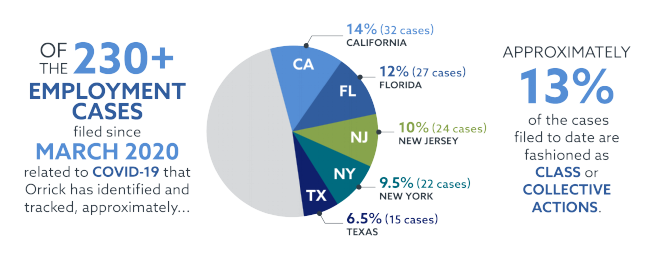COVID-19 Litigation Preparedness
Employment Law Alert
June.24.2020
We have been tracking COVID-19 employment related litigation activity across the country—for a list of common themes we are seeing and best practices to help reduce the risk for your company, read on!
Three months after many Shelter-In-Place orders took effect, we are seeing increased employment related litigation involving allegations related to the COVID-19 pandemic. We are providing you with a summary of the legal issues that are front and center in these cases brought so far, and practical advice to help reduce risk.
What COVID-19 employment related litigation has been initiated thus far? COVID-19 litigation runs the gamut and includes single- and multi-plaintiff cases, class actions and representative actions, requests for injunctions, and more. Cases filed to date have included claims premised on safety violations, discrimination, retaliation, wage and hour violations, focusing primarily on how employers have responded to the COVID-19 pandemic. Businesses that have operated during the lockdown as essential businesses throughout the pandemic have been especially vulnerable to claims.
State Attorneys General have also been active in enforcing business closures and state laws governing commercial activities. Some businesses have faced criminal repercussions for violating state limits on business operations during the pandemic. Governments in various states have also issued civil citations for violations of executive orders.

Can you provide some examples? Here are just a few examples of COVID-19 litigation filed thus far:
- An employee in Pennsylvania sued their employer based on denial of FMLA leave requested because they were in a higher risk category if they contracted COVID-19.
- A multi-plaintiff lawsuit alleges that an Ohio employer’s layoffs related to COVID-19 were pretext for age-based discrimination.
- Healthcare and other essential employees have brought claims alleging retaliation in connection with complaints about unsafe working conditions, including lack of face coverings and/or other safety and sanitation measures in the workplace.
- Employers in multiple states, including Illinois and Texas, are facing wrongful death lawsuits from surviving family members.
- An employee in California sued her employer for disability discrimination and retaliation, alleging she requested leave to care for her sick mother whose daily caregiver was unavailable due to COVID-19 and was subsequently included in a layoff.
What are the main areas of COVID-19 litigation risk, and what can my Company do to prepare? The table below contains a general summary of areas where we have seen or anticipated increased litigation activity relating to COVID-19, as well as practical steps your Company can take to lessen the risk.
|
COVID-19 Litigation Overview Claims and issues may vary by state and location |
||
|
Areas of COVID-19 Litigation |
Litigation Risk1 |
Practical Steps to Lessen Risk |
|
Violation of Stay at Home or Shelter in Place Orders |
|
|
|
Whistleblower / Retaliation |
|
|
|
Wage and Hour |
|
|
|
Layoffs / Reductions in Force / Furloughs
|
It depends on Company’s level of activity in this area… |
|
|
Paid Sick Leave / FMLA |
|
|
|
Disability Discrimination / Failure to Accommodate |
|
|
|
Age, Genetic Information, and Pregnancy Discrimination |
|
|
|
Race, Ancestry, National Origin Discrimination |
|
|
|
Health and Safety
|
|
|
|
Medical Privacy |
|
|
|
Personal Injury (Torts, Negligence, Third Parties)
|
|
|
1This is not intended to predict the risk of litigation or claims for your Company specifically, but rather, as an indication of where we anticipate to see the largest amount of litigation activity relating to COVID-19.
Please reach out to any Orrick contact if you have questions or would like to discuss.


